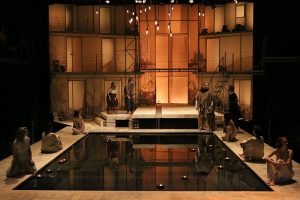
PlayMakers Repertory Company resident designers Jan Chambers and McKay Coble are no strangers to working with water, having collaborated on Shakespeare’s “Pericles” for PlayMakers. But transforming the Paul Green Theatre into a wonderland complete with indoor pool for two upcoming productions took everything to a new level.
The set with pool as the centerpiece will be featured in Shakespeare’s “The Tempest” and Mary Zimmerman’s “Metamorphoses,” playing in rotating repertory Nov. 2 to Dec. 8. Read the full story about the two upcoming productions, with ticket details.
The Set
Chambers did extensive research on aquatic environments of all kinds, from ancient Rome’s Baths of Caracalla to natural phenomena such as glacial lakes, cavern grottos and lush tropical settings to contemporary pools that could grace the pages of Architectural Digest.
With the directors’ vision to guide them, Chambers and Coble focused on abandoned pools, both classical and modern. Examples included Hashima, the abandoned island off the coast of Japan featured in the latest James Bond movie Skyfall, and Picine Molitor, an Art Nouveau swimming complex where Dominique swam years ago before it became dilapidated with nonuse. Now the Parisian landmark is being restored to its former glory thanks to association with the Academy Award-winning Life of Pi.

Coble calls their design a marriage of engineering and art.
What they’ve devised is a structural design with three stories made of translucent plastic, and an open pool filled with 15 tons of water that must be constantly cleaned, heated and recirculated. They’re working with PlayMakers productions shops, utilizing new technologies in fields as diverse as chemicals and welding aluminum. These designers, also faculty members in UNC’s department of dramatic art, call this production ideal for teaching and terrific experience for the students.
The co-productions complement the university’s current academic theme focused on water, called “Water in our World.”
Along with making a magical world, Chambers and Coble must also keep safety first. In this watery space, non-slip surfaces and water-proofing are key considerations, and strong support comes in the form of steel thrusts and platforms with fencing at each level not only for the protection of the cast, but adding to the look of a transitional space, perhaps left mid-way under construction.
Metamorphoses playwright Zimmerman also shared this tip: Make the pool liner black to get the best reflective surface.
The Costumes
In costuming the characters, there is tremendous range and variety to cover with two casts. But then put all the characters poolside, doing the things one can do in a pool — frolic, bathe, dive and drown. The costumes will be constantly splashed if not immersed, says Chambers.
So, associate costume designer Jade Bettin and her team have devised a “wet plot” mapping out who’s wearing what at all times to determine which costume pieces will need to be doubled, whose hair must be dried and when and how many sets of undergarments will be required, in addition to how and where all this will be attended to during quick changes as the stories unfold.
For the designers, it’s all part of the thoughtful, practical work that goes into making theater magic at PlayMakers.
[By Connie Mahan]



